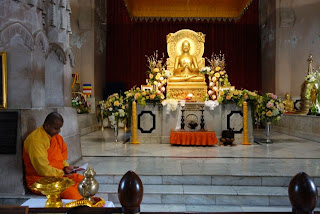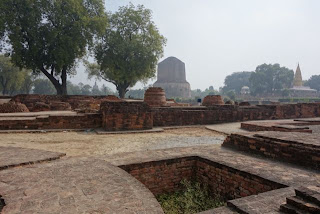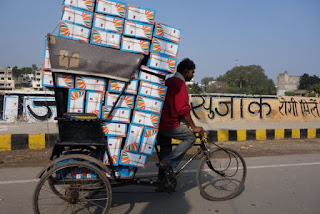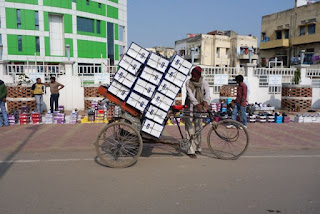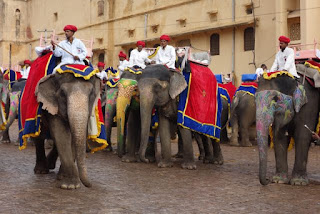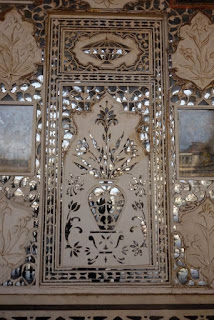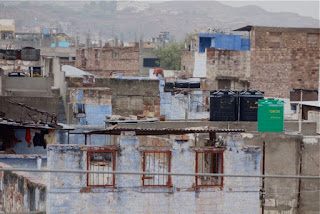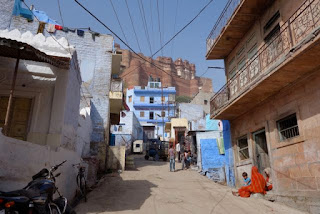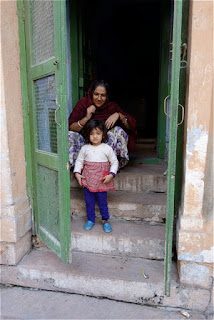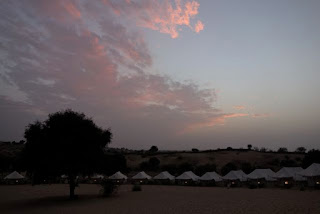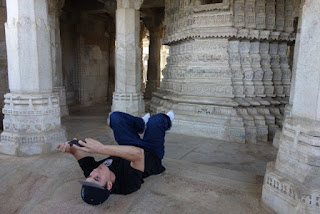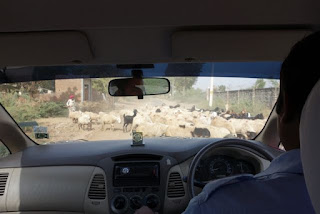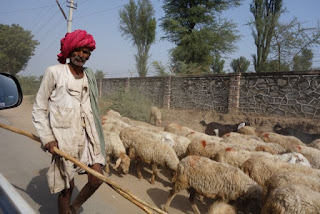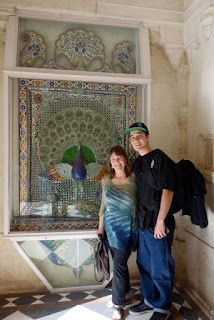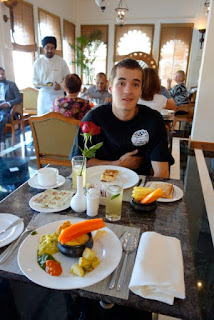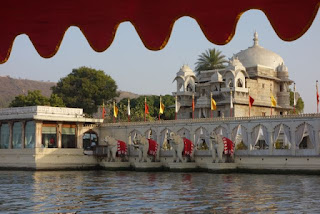Thursday, January 24th,
The India part of our adventure is over and we expect today to be no more than a day of travel and transition.
Our 7:00 A.M. wake up allows us time to pack leisurely before our final pick up for our flight between Varanasi and New Deli. As expected, the Incentive Destination liaison is waiting when we exit our hotels elevator. We are transported seamlessly to the airport but our departing flight is delayed two hours due to heavy fog. We have nothing significant planned for today and I am grateful that we had a clear day yesterday for our morning boat ride on the Ganges.
Our flight to New Deli eventually departs and when we exit the domestic terminal in Deli, a familiar Incentive Destination face holds a Marty Bobroski sign (always minus the e of my last name.) We offload our minimal luggage into the waiting car and an hour later, are deposited at the Inari hotel on the outskirts of the International airport.
Incentive Destination Tours has booked this hotel so that we can relax and sleep until our 2:00 A.M. wake up call for our flight to the U.A.E. The Inari hotel is in a no-man’s land, between the international airport and edged in by a 4 lane freeway. John and I are not good at relaxing and we are hungry and feel trapped in this plush and corporate hotel. The dining room prices equate to a Maharajas ransom and there are no taxi’s or tut tuts waiting outside the hotel. We ask the concierge how we might get into the city and he coldly tells us that is a very long ways away, suggesting instead, a nearby mall, 8 kilometers away. We have not seen a mainstream mall during our trip and this sounds like a good way to pass the afternoon. He tells us that the hotel shuttle will take us there for 1200 rupees each way. ($50 U.S. dollars for 16 kilometers of freeway travel seems excessive and I inquire about a taxi?) He writes down the taxis phone number but is disinclined to call one for us, so we exit indignantly, march down the palatial steps, cross the expansive circular drive way and pass through the hotels security gate. Joyful to be free of the confines of the hotel, we walk another 300 meters towards the main street in search of a tut tut or taxi.
Our flair of independence is blocked by the rushing freeway and we stand defeated in the dirt behind dented guard rails, quickly realizing that there will be no tut tut passing by. A few taxis wiz past but unless the driver spots us well in advance of the road leading to our hotel, it will be impossible for it to pull over and pick us up. There is a small triangle of dirt between the freeway and the off ramp and we stand in our presumably safe triangle and ponder our plight. Just when we are about to return defeated to our hotel, a sedan veers off of the freeway and pulls along side of us. A woman in her late 20’s rolls down the window and asks if we need help? We tell her that we are trying to flag down a taxi to take us to the Mall. Her English is perfect and she tells us that it is doubtful that a taxi will stop here and suggests that we return to the hotel and phone for one. I lamely mutter that I do not have a cell phone and she immediately pulls out her cell phone and makes a call to a taxi service on our behalf. Several minutes later she hangs up, shakes her head and tells us that it will be over an hour before a taxi can be sent. She then makes us an unexpected proposition: She is returning from work, lives nearby and must go home first to relieve the nanny of her toddler. She suggests that it would be a fun outing to go together to the mall and that we ride home with her to pick up her 3 year old daughter, after which she will drive us all to the mall.
I glance over at John; he looks quizzically at me and we slide impulsively into the back seat of her small sedan. She is 28 years old with a 3 year old daughter and lives 5 minutes away. We chat nervously as she drives, each sizing the other up. Minutes later, she pulls off of the freeway, drives a mile along a frontage road and we arrive at the gated entrance to her house? She tells us that we must wait outside while she drives inside a secure compound to pick up her daughter. We accept her “terms” and once again, John and I are standing in the dirt along side of a road. John, more observant than myself, is exchanging cautions glances with an armed guard looming sentry above the gate. I am oblivious, hot and unbearably thirsty and plop down on wooden rail just outside the gate. The tower guard is not pleased by our presence and asks us what we are doing there? (Apparently he did not notice our new friend offload us prior to entering his supposedly secure compound?) I rattle off a nervous explanation which is less than satisfactory to him and he calls down to us, telling us that we cannot wait here. I try again to explain, at the same time shuffling crab like 20 feet down from the entrance. Another armed guard appears from behind the gate, also unsettled and confused by our presence, but happily, the second guard determines that we are not a threat and asks if we would like some water to drink while we wait? I gratefully accept the offer expecting a bottle or glass to be brought to us outside but instead the gate slides open and we are escorted inside the secure compound. We tentatively enter a several room guard house, sink into stained and saggy couches and are handed two glasses of water. The guards have now switched from guarding to hosting and when we greedily drain our glasses of water, another guard brings us glasses of warm sweet tea, pumped from a thermos. Our eyes dart around the room taking in the framed photos on the walls; pictures of armed special force maneuvers, fighter jets and smiling soldiers with their arms thrown over their buddy’s shoulderss. I am no longer nervous and could sit drinking tea comfortably in this cool room with these handsome young soldiers for some time, excepting that our new female friend will be returning with her daughter soon and wondering where we have gone?
The door to the guard house opens, sunlight sneaks in, and a soldier barks that our friend is waiting outside. John and I rise quickly, offer our thanks, and slide again into the back seat of our new friends car. I have forgotten her name but will refer to her as Majaha and her daughter as Sanja. Her 3 year old daughter sits in the front passenger seat, buckled in but without a car seat. John and I sit in back. On our drive to the mall we learn that Majaha is married to a special forces officer and the family lives in the secure army housing compound. Majaha is a teacher/phycologist and was commuting home when she spotted us along side the freeway. The 3 year old Sanja is full of questions, obviously precocious.
The 8 kilometer drive to the mall is fraught with obstacles. Until today, we have not experienced an Indian freeway, but it is commute time in Deli and this multi-lane freeway is moving slowly. We wait in the traffic jam of cars at a freeway toll gate before snaking slowly towards the mall. (I now understand why the hotel charged 1200 rupees for their shuttle.) Pay parking is the only option and Majaha graciously pays the attendant the 30 rupee fee. We are scanned through a security arch and my purse and John’s back pack are put through an x-ray machine before we are allowed entry into the mall.
 |
| Majaha, Sanja and John |
Hours ago, John and I wanted lunch and we are now starving. I offer to treat everyone to a meal and Majaha leads us up a central escalator along the upper level to a small cafe. The decor and menu are very Americanized with cushioned bench seats and low tables. Majaha and Sanja confirm that they are vegetarians and I order a large Greek pizza to share. Everyone has juice smoothies and John orders a additional hamburger and fries. We chat amicably and cater to the antics of an imaginative and hyperactive 3 year old.
After our late lunch we wander the upper level of the mall and 3 year old Sanja tugs us into a gaming arcade. In addition to the usual arcade games there is a mechanical bull and I buy a 300 rupee game token card that we can share. We laugh as John is thrown three times from the bull and I am delighted to watch John and Majaha enjoying competitive games of air hockey and bowling. I am not much for games and am content to keep an eye on Sanja, who is happy to sit at the controls of driving and shooting games, simply watching the bright lights flash. I observe a cultural difference in mothering. It may be that I am the presumed babysitter, but when Sanja wanders off, Majaha seems unconcerned of her daughters whereabouts. Is it that we are in a secure mall or that Indian children are presumed safe from abductions? This may be a healthy outlook because Alisha and I panic instantly if either Molly or Sterling disappear from our site for more than a few seconds. After an hour, I can tell that even John is bored by the games but Snaja begs and whines to stay longer and gets her way. Eventually, Majaha carries her daughter, kicking and screaming from the arcade and I reflect on my daughters competent way of communicating boundaries with her children with minimal tears and tantrums.
Majaha receives a call on her cell phone and her demeanor changes. I imagine it to be her husband; perhaps questioning her whereabouts and wondering why in the hell she picked up two strange American tourists? It is dark when we exit the mall and return home in rush hour freeway traffic. Majaha advises us that she will not be able to take us to our hotel but that she will pull onto the shoulder of the freeway to let us out and that we should climb over the guard rail and walk back to our hotel. Horns honk, brakes squeal and John and I slip from the back seat of her car and quickly climb over the dented guard rail to presumed safety, practically sprinting up the dark drive way towards the lights of our hotel.
We have a 2:00 A.M. wake up call and our plans are to go to bed immediately but when we enter the hotel we see a wedding celebration underway on the garden lawn. The restaurant offers an unobstructed view of the party below and we allow ourselves to be ushered to a window table in the dining room, order a large beer to share, and recount the unusual events of our day.
I am not in Kansas any more and this is the great joy of traveling; the unexpected turn of the road when two cultures interconnect.





















